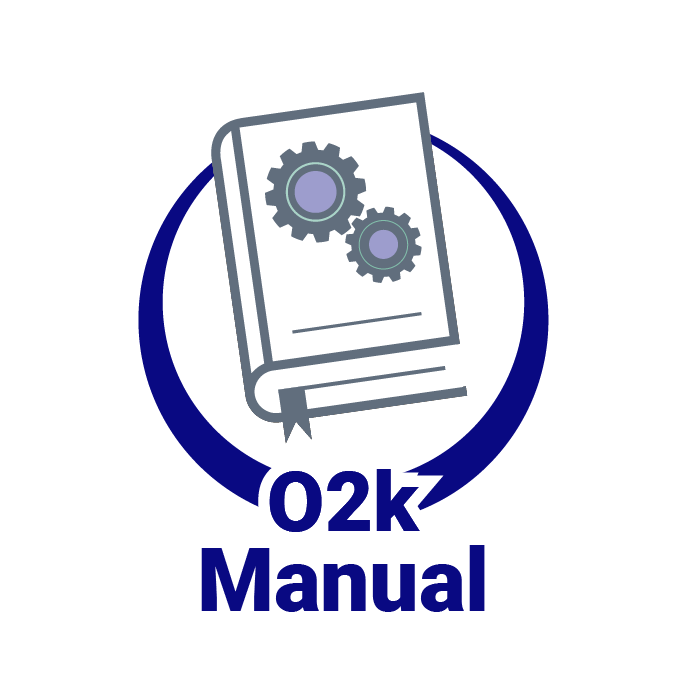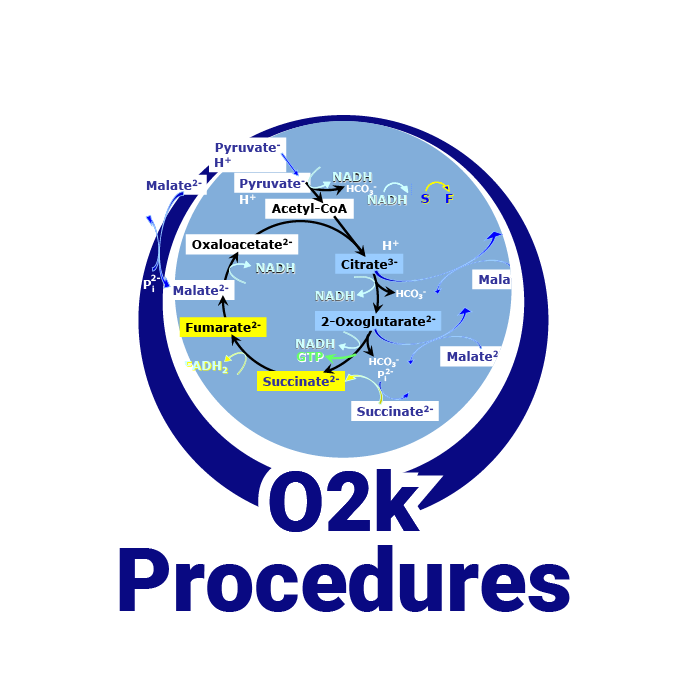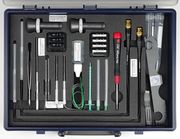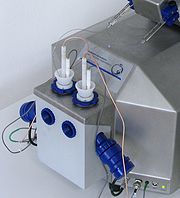|
|
| (62 intermediate revisions by 13 users not shown) |
| Line 1: |
Line 1: |
| {{Mainpage orobopedia}}
| |
|
| |
|
| {{Product | | {{Technical support}} |
| |description='''O2k-TPP<sup>+</sup> and Ca<sup>2+</sup> ISE-Module''': 2 potentiometric ion-selective electrodes ([[ISE]]), ISE-Service Kit and 2 [[Stopper\white PVDF\angular Shaft\side+6.2+2.6 mm Port|PVDF-Stoppers]], supported by the [[O2k-Core]]. | | __TOC__ |
| |product id=12300-01
| | {{MitoPedia without banner |
| |product type=O2k, O2k-Module, MultiSensor, Stopper, Catalogue
| | |abbr= |
| |info=[http://www.oroboros.at/?O2k-MultiSensor O2k-Multisensor @OROBOROS], [[H MiPNet15.03 MultiSensor-ISE|ISE-Manual]], [[Tetraphenylphosphonium]] | | |description=[[File:TPP new.jpg|180px|right]]'''O2k-TPP<sup>+</sup> ISE-Module''': Potentiometric ion-selective electrodes for measurement of mitochondrial membrane potential |
| |product image=[[Image:O2k-TPP-ISE.jpg|180px|right|link=http://www.bioblast.at/index.php/O2k-TPP%2B_and_Ca2%2B_ISE-Module]]
| | |info= [https://www.oroboros.at/index.php/product/o2k-tpp-ise-module/ '''Product details and purchase information'''] |
| }}
| |
| | |
| | |
| | |
| == '''O2k-TPP+ and Ca2+ ISE-Module ''consists of'':''' ==
| |
| {{#ask: mainlabel=Title|[[Category:Products]] | [[Product type::O2k-TPP-Ca ISE-Module]]
| |
| | ?description
| |
| | ?product id
| |
| | ?product image
| |
| |sort=product id
| |
| |order=ascending
| |
| }} | | }} |
|
| |
| __TOC__ | | __TOC__ |
| = General = | | == Additional resources == |
|
| |
|
| The OROBOROS [http://www.oroboros.at/?O2k-MultiSensor ISE system] is designed with replaceable membranes making it possible to measure different ions such as TPP<sup>+</sup> or Ca<sup>2+</sup> with the same electrode housing.
| | :::: »''O2k-Manual:'' [[MiPNet15.03 O2k-MultiSensor-ISE]] |
| | :::: »''O2k-Procedures:'' [[Tetraphenylphosphonium#O2k-technical_support |TPP: O2k-technical_support]][[Image:O2k-TPP-ISE.jpg|180px|right]] |
| | :::: »''O2k-Specifications:'' [[MiPNet15.08 TPP electrode]] |
| | :::: »[[O2k-Catalogue: O2k-Modules| O2k-Modules]] |
|
| |
|
| == O2k-Core and O2k Series A-E ==
| |
|
| |
|
| For the Oxygraph-2k Series A-E, the '''O2k-TPP<sup>+</sup> and Ca<sup>2+</sup> ISE-Module''' is supported by the [[O2k-Core]] and by all O2k instruments with the [[O2k-MultiSensor|O2k-MultiSensor electronic upgrade]].
| |
|
| |
|
| = TPP /TPMP electrode =
| | <br/> |
| | <br/> |
| | <br/> |
| | <br/> |
| | <br/> |
|
| |
|
| The main purpose of the O2k-TPP+ and Ca2+ ISE-Module is to measure [[Mitochondrial membrane potential]] via the TPP or TPMP method.
| | == Calcium electrode == |
| | »''Membranes:'' [[ISE-Ca2+ Membranes]] |
|
| |
|
| The first publication using the O2k-TPP+ and Ca2+ ISE-Module for this purpose was [[Brown 2011 Am J Physiol Regul Integr Comp Physiol]]
| | <br/> |
|
| |
|
| | {{Keywords: Force and membrane potential}} |
|
| |
|
| = Calcium electrode =
| | {{MitoPedia O2k and high-resolution respirometry |
| | | |mitopedia O2k and high-resolution respirometry=O2k hardware, O2k-Open Support |
| We recommend to use fluorescence methods for measuring Ca<sup>2+</sup> concentrations, utilizing the [[O2k-Fluorescence LED2-Module]]. Fluorescence based methods for detection of Ca<sup>2+</sup> are more easy to set up and are more widely used in biosciences than ISE based methods. However, there may be special applications in which determination of Ca<sup>2+</sup> levels via ISE is advantageous. The use of a Ca2+ electrode in mitochondrial research was described by Moreno et al. <ref>Moreno AJM, Vicente JA (2012) Use of a Calcium-Sensitive Electrode for Studies on Mitochondrial Calcium Transport. In: Mitochondrial bioenergetics: methods and protocols (Series Editor: Sir John Walker), edited by Carlos Palmeira and António Moreno. </ref>Also a laboratory already using the [[O2k-TPP%2B_and_Ca2%2B_ISE-Module]] but without funds for the [[O2k-Fluorescence LED2-Module]] may want to use ISE based Ca<sup>2+</sup> detection. For this purposes [[ISE-Ca2+ Membranes]] suitable for use with the [[O2k-TPP%2B_and_Ca2%2B_ISE-Module]] can be ordered from OROBOROS instruments and are described here:
| | }} |
| | | {{MitoPedia topics}} |
| A Ca<sup>2+</sup> selective membrane with a composition similar to the one described by Simon and coworkers <ref>Schefer U, Ammann D, Pretsch E, Oesch U, Simon W (1986) Neutral carrier based Ca<sup>2+</sup>-selective electrode with detection limit in the sub-nanomolar range. Analyt Chem 58: 2282-2285.</ref> has been tested with the OROBOROS ISE system and detection limits of less than 10 nM were achieved in Ca<sup>2+</sup> buffered calibration solutions. There may be further optimizations of the membrane composition to ideally fit the the typical applications of OROBOROS customers. However, the main obstacle in establishing useful Ca<sup>2+</sup> measurements appears to be not the Ca<sup>2+</sup> sensitive membrane but the methodology of its application in a medium simulating intracellular conditions.
| |
|
| |
| ''Note: The operation of a Ca<sup>2+</sup> electrode at typically high extracellular Ca<sup>2+</sup> concentrations is straightforward and devoid of the difficulties described here.'' These difficulties include both the calibration of the Ca<sup>2+</sup> electrode and the planning of a biological experiment to use it.
| |
| | |
| [[ISE-Ca2+ Membranes]] for use in the Oroboros ISE system can be ordered separately.
| |
| == Operation of the Ca<sup>2+</sup> electrode ==
| |
| | |
| === General ===
| |
| The general operation (assembly, ...) of the Oroboros ISE system is described in [http://www.oroboros.at/?O2k-MultiSensor MiPNet15.03].
| |
| | |
| While working with the pX channel please always observe the guidelines for avoiding damage to the electronics by [[ESD]].
| |
| | |
| === Calculation of free Ca<sup>2+</sup> concentrations ===
| |
| To work at physiological Ca<sup>2+</sup> concentrations requires usually Ca<sup>2+</sup> buffering by chelating agents. The calculation of ''c''(Ca<sup>2+</sup>)<sub>free</sub> in such solutions is quite complicated and the results depend i.a on ionic strength, temperature, and - very strongly - on the pH. Tools for such calculations are available on-line at Chris Pattons MAXCHELATOR Page [http://maxchelator.stanford.edu/ maxchelator.stanford.edu]. Many calculations, published or implemented in programs, depend on a single set of data compiled by Martell and Smith <ref>Martell AE, Smith RM (1989) Critical Stability Constants, 1: Amino Acids. Plenum Press</ref>.
| |
| Note that in spite of the availability of easy to use software tools the calculation of free Ca<sup>2+</sup> concentration is not simple. The accuracy of these calculations is severely limited by several factors:
| |
| * Many underlying thermodynamic constants may not be known precisely
| |
| * Some thermodynamic constants necessary for adequate temperature correction may not be known at all
| |
| * It may be difficult to set the experimental parameters pH and ionic strength with the necessary precision
| |
| Commerercial calcium calibration are available from Invitrogen: Calcium Calibration Buffer Kits (C3008MP, C3009, C3723) and Calcium Calibration Standard Kit (C6775).
| |
| | |
| | |
| === Inner filling solution ===
| |
| The following inner filling solution is used:
| |
| CaCl<sub>2</sub>: 10 mM
| |
| | |
| EDTA: 50 mM
| |
| | |
| pH adjusted to 8.5 with KOH
| |
| | |
| | |
| === Conditioning ===
| |
| Conditioning of the membrane is a controversial topic. If any conditioning is done, the used free Ca<sup>2+</sup> concentration should probable not be much higher than the highest expected concentration during applications of the electrode.
| |
| | |
| === Calibration ===
| |
| As a potentiometric method, the Ca<sup>2+</sup> electrode delivers a signal that is (in the working range) linear to the logarithm of the free Ca<sup>2+</sup> concentration. Therefore, the electrode is calibrated by plotting electrode signal vs. logarithm of the free Ca<sup>2+</sup> concentration. Calibration of the Ca<sup>2+</sup> electrode at low (< 1µM) Ca<sup>2+</sup> levels is typically done by exposing the electrode to a series of Ca<sup>2+</sup> calibration buffers. Each calibration solution typically contains a Ca<sup>2+</sup> chelating agent, a pH buffer, CaCl<sub>2</sub>, and a salt (KCl) to adjust ionic strength. For suggested compositions see the literature in the reading list below. Examples from the literature may then be adapted to individual needs using the software tools mentioned above. The pH of all solutions have to be adjusted very carefully. For calibrations spanning a large range (several orders of magnitude) of free Ca<sup>2+</sup> concentrations it is necessary to use calibration buffers with very different compositions. The nonlinearity of the electrode response in such calibrations may be mainly due to the difficulties in calculating the free Ca<sup>2+</sup> concentration.
| |
| | |
| == Application in biological experiments ==
| |
| You could help us in the development by explaining what you would like to do/ see in a Ca<sup>2+</sup> experiment and what you expect from the electrode: what ca concentrations do you want to measure, Ca<sup>2+</sup> release or uptake? what total concentration change in a 2 ml chamber (!) do you expect? Do you want to measure in a Ca buffered medium? (decreased sensitivity to changes) or without Ca<sup>2+</sup> buffering but then how do you get to physiological Ca<sup>2+</sup> concentration? Do you want to measure at physiological Ca<sup>2+</sup> concentrations?.......
| |
| | |
| * Please add your comments in the [[Talk:O2k-TPP+ and Ca2+ ISE-Module|Discussion page]]. Pease contact instruments@oroboros.at to recive an account.
| |
| | |
| * user feedback: FCCP may be incompatibe with the function of the [[ISE-Ca2+ Membranes]]. [[User:Fasching Mario|Fasching Mario]] 11:45, 2 November 2012 (CET)
| |
| | |
| == Reading list ==
| |
| | |
| We have complied a short reading list that may be of interest to those planing to to do Ca<sup>2+</sup> measurements, with special emphasis on references describing the preparation of Ca<sup>2+</sup> calibration buffers.
| |
| | |
| [[Media:Ca_reading_list.pdf|Ca measurement reading list]]
| |
| | |
| | |
| == Advanced Diagnostic tests for the ISE system ==
| |
| Sometimes it is difficult to find out whether problems with the ISE system are caused by the electrodes (TPP, Ca, reference, pH) or by the pX electronics of the O2k. The following two tests can help to solve this question.
| |
| | |
| === Testing a TPP system with a pH electrode (and vice versa) ===
| |
| This method allows to test the sensitivity of the pX electronics.
| |
| | |
| '''Requirements'''
| |
| | |
| Another type of electrode than can be connected to the ISE system. So if the problem is observed with an ISE system for measuring TPP, a pH electrode is the usual choice because it is available in many labs. The only requirements for the second electrode is that it can be connected via a BNC port. It does not have to be an electrode from OROBOROS Instruments neither is it necessary that the electrode fits into the O2k chamber.
| |
| | |
| '''Procedure'''
| |
| * Connect the pH electrode to the oxygraph.
| |
| * Put the electrode into a pH 4 calibration buffer (event)
| |
| * Observe (record) the signal in DatLab.
| |
| * Put the electrode into a pH 7 calibration buffer (event). Obviously the sequence of buffers does not matter.
| |
| * From such a DatLab file we will see whether the pX electronics is working and even get a very rough estimation of the gain.
| |
| | |
| === Testing TPP or pH electrodes with a voltmeter ===
| |
| This test measures the performance of the electrodes independently form the pX electronics of the O2k.
| |
| | |
| '''Requirements'''
| |
| | |
| Any voltmeter,frequently labeled "Multimeter" if different measurement modes can be selected, suitable for measuring mV potentials. .
| |
| | |
| '''Procedure for TPP electrodes'''
| |
| * Set up the TPP /reference electrode in the O2k chamber as usually, only medium in the chamber.
| |
| * Connect the electrodes to the pX electronics and record the signal.
| |
| * Disconnect both electrode cables from the O2k (but leave the electrodes in the chamber, stirring still on).
| |
| * If you have a "Multimeter" available set in into "Voltmeter mode"
| |
| * Set the recording range of the voltmeter to a range good for recording about 200 mV
| |
| * now measure the voltage difference between reference electrode and TPP electrode by touching (ideally fixing) the two probes of the voltmeter to the ends of the cables from the electrodes: for the reference electrodes this is simply the gold colored pin, for the TPP electrode this is the INNER , central pin. Note down the voltage reading on the voltmeter display. For this step the help of a second person is most convenient, otherwise you probable have to find a way to fix the cables in some way. It is not necessary to have the voltmeter in contact with the electrodes all the time, just when you are reading the values.
| |
| * Increase the TPP concentration in a few (lets say 5) rather large steps (at least 2 µM per step) and note down the displayed values.
| |
| * Finally reconnect the electrodes to the pX electronics of the O2k and observe how much (if at all) the signal has changed there. * Please send us the recorded values along with the TPP concentrations used and the the DatLab file recorded at the same time (that shows the readings for the first and last point). If no change in signal is visible with the voltmeter, the problem is at the TPP electrode, not the O2k.
| |
| | |
| '''Procedure for pH electrodes'''
| |
| | |
| * Follow the procedure for TPP electrodes, moving the pH electrode between different pH calibration buffers instead of doing a TPP titration.
| |
| | |
| == References ==
| |
| | |
| <references/>
| |
| | |
| <br>
| |
| {{#set:Technical service=Ca}}
| |
| | |
| <br> {{Technical service}}
| |







